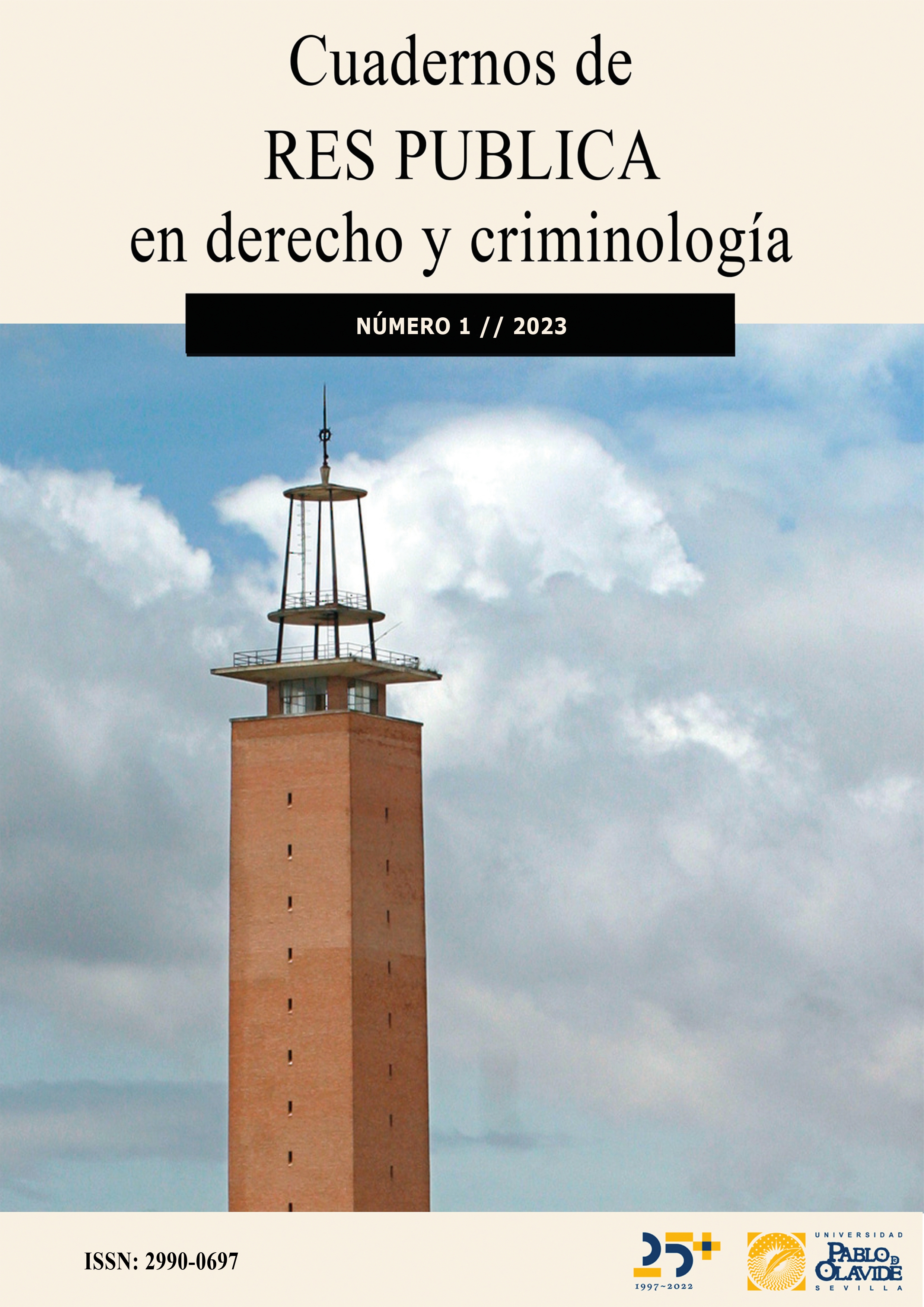Criminological study of the cybercriminal and his victims
DOI:
https://doi.org/10.46661/respublica.8072Keywords:
Cyber victim, Cyber crime, Cyber offenderAbstract
Social networks, shopping websites, discussion forums or access to any type of information and content are a space where each person can adopt a different role (Chou, T., 2015). At the same time as this evolution for the correct use of the network, a complex criminal network has developed, which manages to circumvent any security measures that have been tried to be implemented. This paper will analyse the main criminal data through the network between 2015 and 2019, looking for the cause of these and the possible justifications for the lack of clarification of criminal acts, whether they affect individuals or groups, based on the data provided by the Ministry of the Interior. This work aims to provide an approximation of the figure of the cyber victim, the characteristics of the two figures it comprises: the offender and the victimDownloads
References
CARRERA CALDERÓN, FRANKZ ALBERTO; QUILLIGANA BARRAQUEL, JOEL ESTUARDO; AGUILAR MARTÍNEZ, MARIO DANILO; y FIALLOS BONILLA, SANTIAGO FERNANDO. (2019). Desafío de la ciberseguridad ante la legislación penal. Dilemas contemporáneos: Educación, Política y Valores. https://doi.org/10.46377/dilemas.v31i1.1236
CENTENO, DAVID. (2015). "El ataque se puede producir desde cualquier ubicación del mundo". El País. Recuperado de https://elpais.com/tecnologia/2015/01/27/actualidad/1422371877_899702.html
CHAUHAN, ANKUR KUMAR, SANJEEV & SANYAL, SUGATA. (2021). Intelligent phishing detection system using machine learning. International Journal of Advanced Science and Technology, 30(4), 488-496. https://doi.org/10.48175/IJARSCT-3801
CHEN, XIAOMING ZHOU, WEI & WANG, HONGXIN. (2021). A survey on artificial intelligence in cyber security. Journal of Cybersecurity, 7(1), 1-25. https://doi.org/10.1093/cybsec/tyaa018
CHOU, SAM, & CHOU, JONATHAN. (2015). Cybersecurity: The essentials. CRC Press.
CRUZ-BELTRÁN, JOSÉ. LUIS y LIZ-RIVAS, LENNY (2019). El perfil del ciberterrorista: la utilización de medios informáticos con fines terroristas, en; “El conflicto y su situación actual: del terrorismo a la amenaza híbrida”, coord. por Carlos Espaliú Berdud, CIVITAS, pp. 159-173.
CURTIS, PAUL. (2011). The construction of the cyberspace: Metaphors and narratives of the web. In S. S. Yu & X. In (Eds.), Proceedings of the 2011 International Conference on Information Science and Applications (pp. 1-5). IEEE. https://doi.org/10.1109/ICISA.2011.5772305
DELGADO MORÁN, JUAN JOSÉ. (2023). Políticas públicas de seguridad en España. Análisis desde perspectivas criminológicas. Revista Opinião Jurídica, Fortaleza, v. 21, n. 37, p. 183- 211, maio/ago. http://dx.doi.org/10.12662/2447-46641oj.v21i37.p183-211.2023
DE LA CUESTA ARZAMENDI, JUAN LUIS y SAN JUAN, CARLOS. (2010). La cibercriminalidad. Derecho penal informático, 57-78.
DE LA CUESTA ARZAMENDI, JUAN LUIS y PÉREZ MACHÍO, ANA ISABEL. (2010) Ciberdelincuentes y ciber víctimas. Derecho penal informático, 99-120
DE LA CUESTA ARZAMENDI, JUAN LUIS, PÉREZ MACHÍO, ANA ISABEL y SAN JUAN, CARLOS. (2010) Aproximaciones criminológicas a la realidad de los ciberdelitos. Derecho penal informático, 79-88.
FRIEDMAN, BATYA & KAHN, PETER. (2018). Human values, ethics, and design. In The Routledge Handbook of Philosophy of Engineering (pp. 408-419). Routledge.
GARCÍA-MARTÍNEZ, RAFAEL; GARCÍA-SÁNCHEZ, FRANCISCO; LÓPEZ-CORONADO, MARIO, & BUENO-CRESPO, ANDRÉS. (2021). Artificial Intelligence and Cybersecurity: A Review of Recent Research. Electronics, 10(7), 733. https://doi.org/10.3390/electronics10070733
Gartner report (2018). Gartner Says 30 Percent of Companies Will Use Artificial Intelligence to Augment at Least One of Their Primary Sales Processes by 2020.
GOPE, PRASENJIT & BISWAS, GUSTAM. (2020). An AI-based approach for detecting phishing websites. Multimedia Tools and Applications, 79(5-6), 4075-4093. https://doi.org/10.1007/s11042-019-08497-9
GOROSTIDI, JOKIN. (2020). La pluralidad de víctimas derivada de la elevada lesividad en los ciberdelitos: una respuesta penal proporcional. Estudios de Deusto, 68(1), 201-221. https://doi.org/10.18543/ed-68(1)-2020pp201-221
KSHETRI, NRIPENDRA. (2018). Blockchain’s roles in meeting key supply chain management objectives. International Journal of Information Management, 39, 80-89. https://doi.org/10.1016/j.ijinfomgt.2017.12.005
LIZ-RIVAS, LENNY. (2018). Algunas bases neurológicas sobre la violencia y la agresión, en ;“Conflictos y diplomacia, desarrollo y paz, globalización y medio ambiente “ coord. Por Emilio José García Mercader, Claudio Payá Santos; César Augusto Giner Alegría (dir.), Juan Jose Delgado Morán (dir.), Thomson Reuters/Aranzadi, pp. 943-955
LUQUE JUÁREZ JOSÉ MARÍA, y LIZ-RIVAS, LENNY. (2021) Factores ligados a la violencia de género, evaluados en la valoración policial del riesgo, en; “Vulnerabilidad de las víctimas desde la perspectiva de género. Una visión criminológica”. Víctor Rodríguez González (dir), Ana María Fuentes Cano, Dña. Tara Alonso del Hierro y D. Jonathan Torres Téllez.(coords), Dykinson, pp. 243-256. https://doi.org/10.2307/j.ctv282jjsk.15
MARTÍNEZ ATIENZA, GORGONIO Y FERNÁNDEZ BERMEJO, DANIEL. (2020). Ciberdelitos. Ediciones Experiencia.
MAROTTA, ANTONIO & RICCIADI, FEDERICA. (2017). Cybersecurity in SMEs: A literature review. Journal of Business Research, 84, 1-13. doi: 10.1016/j.jbusres.2017.11.011
MENDEZ, ANA MOURA, PAULO & PAULO NOVAIS, PAULO. (2018). Intelligent phishing detection system. International Journal of Information Management, 38(1), 137-147. doi: 10.1016/j.ijinfomgt.2017.09.004
Ministerio del interior (2019). Estudio sobre cibercriminalidad en España. NIPO 126-20-021-2
PAYÁ SANTOS, CLAUDIO. AUGUSTO., y DELGADO MORÁN, JUAN. JOSÉ. (2016). El uso del ciberespacio para infringir el terror. Estudios en Seguridad y Defensa, 11(22), 91-108.https://doi.org/10.25062/1900-8325.211
PEÑALOZA, BERNARDO. (2019). Mendoza: hacia un Código Procesal Penal adecuado para la investigación de ciberdelitos. In XIX Simposio Argentino de Informática y Derecho (SID 2019)-JAIIO 48 (Salta).
SINDRE, GUNNAR & OPDAHL, ANDREAS. (2011). A threat modelling approach to identification of security requirements. Information and Software Technology, 53(5), 490-503. doi: 10.1016/j.infsof.2010.12.005
SHOUHUAI & SASTRY, SRIRMAN. (2015). Metrics for cyber resiliency evaluation. Computers & Security, 52, 10-23. doi: 10.1016/j.cose.2015.04.005
VERDEJO ESPINOSA, MARIA ANTONIO (2015). Ciberacoso y violencia de género en las redes sociales. Universidad Internacional de Andalucía. ISBN: 978-84-7993-281-7
WANG, ZHE; ZHANG, YANCHAO; REN, KUI & LOU, WENJING. (2020). AI-Supported Cybersecurity in Smart Homes: Challenges and Opportunities. IEEE Network, 34(1), 88-95. https://doi.org/10.1109/MNET.001.1900275
WHITMAN, MICHAEL & MATTORD, HERBERT. (2016). Management of Information Security. Cengage Learning.
ZUNZUNEGUI, SERGIO. (2008). Pensar la imagen. Akal.
Downloads
Published
How to Cite
Issue
Section
License

This work is licensed under a Creative Commons Attribution-NonCommercial-ShareAlike 4.0 International License.




